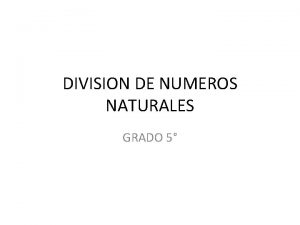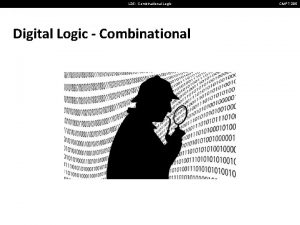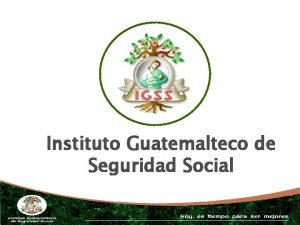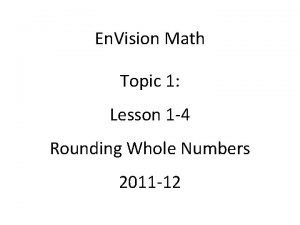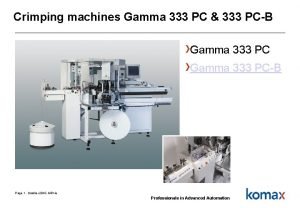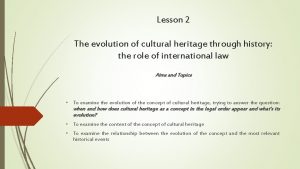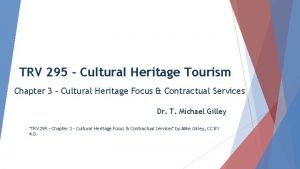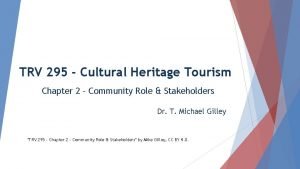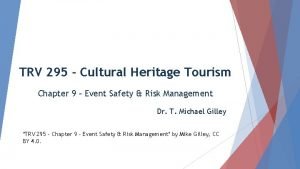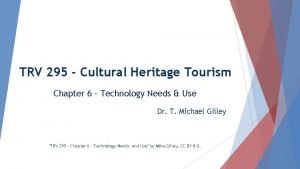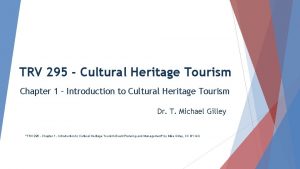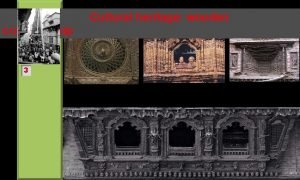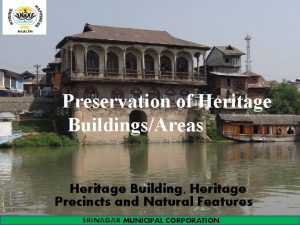TRV 295 Cultural Heritage Tourism Chapter 5 Site













- Slides: 13

TRV 295 - Cultural Heritage Tourism Chapter 5 – Site Selection and Planning Dr. T. Michael Gilley "TRV 295 - Chapter 5 – Site Selection and Planning" by Mike Gilley, CC BY 4. 0.

Site Selection: Where will the event be? ▶ Now that you have determined what cultural heritage event you will be having, where is the best site to hold the event? ▶ Since the event is a cultural heritage event, to be the most authentic, you need to hold the event in the geographic area where the cultural heritage is located. For example, an Appalachian cultural heritage festival on crafts, music, storytelling, dance, foodways, etc. would be more authentic if held in an Appalachian area just as a Tex-Mex cultural heritage festival would be best held in Texas and surrounding area. ▶ What type of event will you be holding to demonstrate or celebrate the cultural heritage – a concert, a lecture, a demonstration, a class, a festival? ▶ Will the event be a one time event or an event held more than once? If held more than once will it be ongoing or just a series of programs held once. If ongoing will it be weekly like a music jam or class, or weekly/monthly like a music concert or lecture series or a craft guild, or annually like a concert or festival.

Site Selection (cont’d): ▶ The type of event and the frequency will also impact the site required for the event taking in consideration size of the potential audience, whether the event will need to be indoors or outdoors based upon time of year and weather conditions, requirements for shelter and acoustics for people, crafts, and music instruments. ▶ The type of event will also impact the site selection in terms of size of site and amentities / equipment required. Will you need a stage with audience seating, or classroom with tables? Will you need a projector and screen, a sound system with a single microphone or multiple microphones and a mixer? How many speakers will be required to project the sound for the size of auditorium or outdoor space?

Site Selection Checklist: ▶ Vision and Mission Statements Support: ▶ the purpose of the event must be addressed by the event and accommodated by the site such as the following: ▶ accessibility for all ages and disabilities; ▶ administration and staff needs; ▶ admission gates for collecting & selling tickets / armbands / counting attendance; ▶ adult & youth entertainment areas, interactive and supervised; ▶ communications, on and off-site; ▶ crowd capacity; ▶ destination potential and proximity to towns and other hospitality services; ▶ directional signs; ▶ entertainment areas – themes, temporary or permanent, structures, tents, seating capacity, tables, shade/shelter, sound systems, other equipment, stages and accommodations for performers;

Site Selection Checklist (cont’d): ▶ entrances and exits with traffic flow; ▶ environmental concerns – green technologies, grounds keeping, and maintenance; ▶ indoor / outdoor / both; ▶ marketing strengths; ▶ parking; ▶ pedestrian flow; ▶ permits; ▶ public address system (site-wide and individual entertainment areas); ▶ recycling; ▶ restrooms; ▶ risk management;

Site Selection Checklist (cont’d): ▶ room for growth; ▶ scheduling; ▶ utilities; ▶ waste management.

Site Selection Checklist (cont’d): ▶ Visitor Accommodations, Comfort, and Conveniences Support: ▶ accessibility – services, signage, entrance and exits and mobility issues for visitors and staff; ▶ food onsite such as concessions and dining facilities as well as off-site such as restaurants, grocery stores, and convenience stores; ▶ hotels, motels, bed and breakfasts, cabins, campgrounds, and rental houses; ▶ list of accommodations, dining options, businesses, conveniences, emergency services, travel services, and other tourist and entertainment attractions with addresses, telephone numbers, email, and website links; ▶ maps of towns and cultural heritage event site; ▶ website for event as well as brochures/pamphlets for distribution as tourist and rest areas, local businesses, and mailing;

Site Selection Checklist (cont’d): ▶ Safety and Security Support: ▶ communications, on-site and off-site among various staff by cell phone, walkietalkies, regular phone, texting, email, social media, and signage; ▶ emergency services on-site with ambulance/rescue squad, trained emergency medical technicians; ▶ security with local assistance on site with local police and sheriff as well as private security forces; ▶ traffic control with assistance with state transportation department.

Case Study 1 – Blue Ridge Folklife Festival ▶ Blue Ridge Folklife Festival is both an indoor / outdoor event for one day. It addresses most of the items on the checklists for supporting the vision and mission for the festival, visitor accommodations, comforts and conveniences, and safety and security. ▶ Blue Ridge Folklife Festival is held on the campus of Ferrum College which is located in a rural area, but within a reasonable driving distance of Rocky Mount and Roanoke, VA. ▶ Supervised by the Blue Ridge Institute and Museum, the festival is excellent in supporting the vision and mission to preserve the folklife of the Blue Ridge region.

Case Study 2 – Home Craft Days ▶ Home Craft Days is primarily an outdoor event with some indoor activities for two days and one evening. It addresses most of the items on the checklists for supporting the vision and mission for the festival, visitor accommodations, comforts and conveniences, and safety and security. ▶ The festival is held on the campus of Mountain Empire Community College. Due to being near a small town, the visitor accommodations are limited; however, more accommodations are available in nearby towns within a short drive. ▶ Although the cultural heritage focus of this festival has decreased over the years particularly with the focus on regional foods and craft demonstration, the college has done a very good job in recording the heritage music and storytelling over the year with producing digital master recordings of performances and CD anthologies. More work could be done with the documentation and preservation of the heritage arts, crafts, and foodways.

Case Study 3 - Merfe. Fest ▶ Merle. Fest is both an indoor / outdoor event for three and a half days. It addresses most of the items on the checklists for supporting the vision and mission for the festival, visitor accommodations, comforts and conveniences, and safety and security. ▶ Merle. Fest is held on the campus of Wilkes Community College in Wilkesboro, a large town surrounded by a rural area in western North Carolina. ▶ Supervised by the Wilkes Community College, the festival is excellent in supporting the vision and mission to support economic development, in particular to be a major fund raiser for the college. While economic development is the primary focus of this festival, the festival doe present heritage music and crafts to document the heritage culture of the region. ▶ Merlefest is a premier example of cultural heritage tourism, generating over 15 million dollars in local and regional financial support from cultural heritage, even though the cultural heritage is not just limited to the Appalachian region’s heritage of the past. Other forms of music are featured at this festival.

Assignment for Chapter 5: ▶ ▶ Review the site selection checklist and select one activity that the event you chose for your case study does to address: ▶ the vision and mission statements; ▶ the visitor accommodations, comfort, and conveniences support; and ▶ the safety and security support. In the discussion thread for this assignment, post your response with your description of how this group addresses each of the three above areas. Do you think the activity you describe is sufficient or could it be improved? If it needs improvement, describe your recommendation for improvement.

Resources ▶ de. Lisle, L. J. (2014). Creating special events. Urbana, IL: Sagamore Publishing. ▶ Gilley, T. M. (2016). Institutions of higher education and cultural heritage tourism: A case study of the Crooked Road, Virginia’s heritage music trail. Ann Arbor: Pro. Quest. ▶ Roueche, J. E. & Jones, B. R. (2005). The entrepreneurial community college. Washington, DC: Community College Press.
 Sapratibandha daya and apratibandha daya
Sapratibandha daya and apratibandha daya World heritage is our heritage slogan
World heritage is our heritage slogan Sapratibandha
Sapratibandha Que es la division
Que es la division Pages 294 and 295
Pages 294 and 295 Cmpt 295
Cmpt 295 Decreto 295
Decreto 295 Round 493 295 to the nearest ten thousand
Round 493 295 to the nearest ten thousand Round 160 656 to the nearest hundred thousand
Round 160 656 to the nearest hundred thousand Komax ims 295
Komax ims 295 Kj no 295
Kj no 295 Cultural heritage meaning
Cultural heritage meaning Intangible cultural heritage and sustainable development
Intangible cultural heritage and sustainable development Hudhud chants of the ifugao threats
Hudhud chants of the ifugao threats



